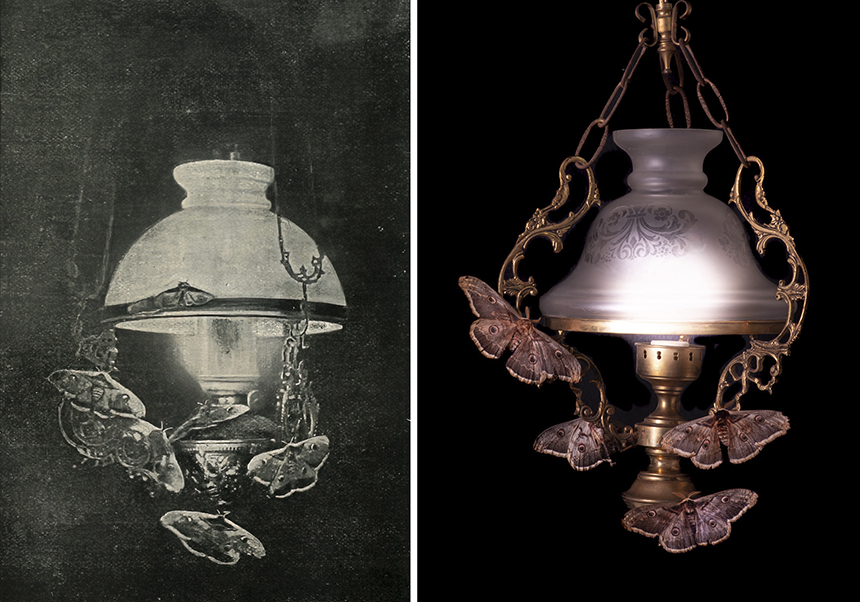Jean-Henri Fabre – Souvenirs entomologiques, series 9, chapter “Le Grand Paon.” Diorama composed of male specimens from the teaching collection of the Department of Zoology at the University of Valencia. It reproduces one of the photographic plates that accompany the Souvenirs entomologiques, series, taken by Paul H. Fabre, the author’s son.

Jean-Henri Fabre devotes an entire chapter of the Souvenirs entomologiques to what he called “The Night of the Great Peacock” (Great Peacock or EmperorMoth, Saturnia pyri). The account takes place in Avignon (France) on May 6, 1870. That evening, from a cocoon collected months earlier near his home, a female moth emerged. Fabre placed her under a mesh-covered dome in his study, intending to release herlater.
Around 9 p.m., the house was suddenly filled with male moths: nearly forty gathered despite the complete darkness and the vegetation surrounding the building. For Fabre, this “nuptial commotion” demonstrated that the males were guided by some invisible emanation coming from the female.
As usual, Fabre began a series of experiments and observations to uncover the mechanism behind this attraction system. Since male moths differ from females specially in their pectinate (comb-like) antennae, he clipped the antennae of a groupof 24 males caught the night before and released them. None of them found the female the following night, while those whose antennae remained intact reappeared. He thus concluded that the antennae are the organ that receives the stimulus.
He also experimented by changing locations. He moved the female to different room seach evening, even placing her inside boxes that were then putin side other boxes, then in cupboard sor cellars, etc. Nonetheless, the males continued to find her. He concluded that the signal must pass through walls and vegetation, and therefore could not be visual or acoustic.
However, he misinterpreted the next experiment. To test whether the signal was anodorous substance, he placed naphthalene and other volatile, strong-smelling chemicals around the cage; the attraction did not diminish. Therefore, he concluded it could not be a chemical compound either, and even speculated that the signal might be dueto radio wavesor ultrasounds.
But the definitive answer came the followingy ear, when, to his surprise, in the spring, males continued to seek the female in the same box where she had been confined the previous year—even though her body had been removed after death, since this species, in its adult (moth) stage, lives only a coupleof weeks.
Thus, the mystery wass olved: Fabre inferred the existence of an extremely powerful and specific chemical “effluvium” that is imperceptible to the human sense of smell butis detected by males from distances of at least hundreds of meters, possibly kilometers, using their antennae.
Today we know that the female S. pyri emits a cocktail dominated by (Z,E)-9,11-tetradecadienyl acetate, accompanied by small amount sof homologous aldehydes and alcohols. This sex pheromoneis detected at concentrations as low as few parts per billion; males are able to follow the pheromone from over 1 km away, and in other saturniids, flights of 5–10 km have been recorded under optimal conditions. Most nocturnal moths—and a vast number of insects and other invertebrates—use sex pheromones to locate mates.
“The Night of the Great Peacock” (May 6, 1870) is the first “modern” essay to demonstrate, using experimental methods, that the sexual attraction of some insects depends on a volatile molecule imperceptible to human smell. This discovery was crucial, and for decades now it has been widely applied to control, monitor, or disrupt agricultural and forest pests: synthetic diffusers mimic the female, attracting or disorienting males and reducing egg-laying without insecticides.
Even in our own homes, when we hang a small diffuser bought at the supermarket to prevent the appearance of pantry or clothes moths, we are—without knowing it—benefiting from that casual observation Fabre made on May 6, 1870, in a small village near Avignon.

















